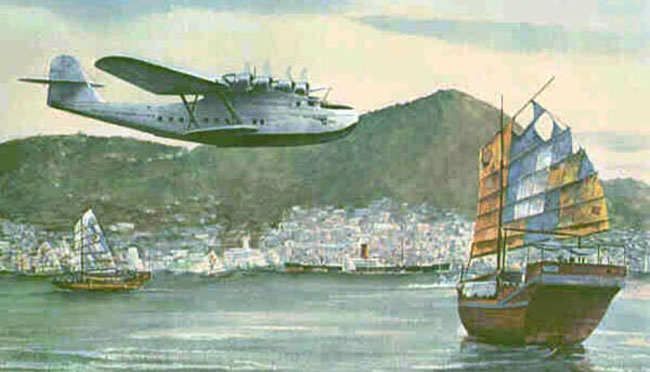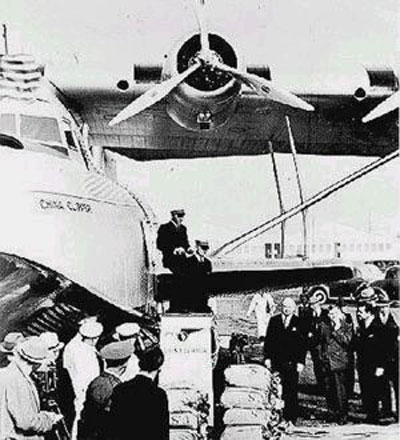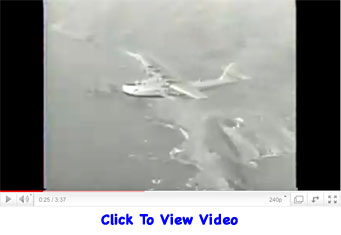China
Clipper Conquered
Pacific 75 Years Ago

 Soon
after establishing the airline and launching service throughout Central
America and the Caribbean from his South Florida base, Pan Am’s
legendary founder, Juan Trippe, set his sights on crossing the North Atlantic.
But he lacked the landing rights on both sides of the Atlantic, and his
British counterpart, Imperial Airways (British Air), lacked the aircraft
technology to compete with Pan American Airways. The British therefore
thwarted transatlantic negotiations, and he turned his attention westward
to the vast Orient. Trippe, a man of unparalleled foresight, had the audacity
to encompass the world in his master plan of creating a global air system. Soon
after establishing the airline and launching service throughout Central
America and the Caribbean from his South Florida base, Pan Am’s
legendary founder, Juan Trippe, set his sights on crossing the North Atlantic.
But he lacked the landing rights on both sides of the Atlantic, and his
British counterpart, Imperial Airways (British Air), lacked the aircraft
technology to compete with Pan American Airways. The British therefore
thwarted transatlantic negotiations, and he turned his attention westward
to the vast Orient. Trippe, a man of unparalleled foresight, had the audacity
to encompass the world in his master plan of creating a global air system.
In 1930 he acquired a large, terrestrial
globe, which was probably the most conspicuous piece of furniture in his
office. He was pictured standing next to the globe with a piece of string
in his hand, which he used to measure distances. The globe’s axle
must have gotten a little squeaky from constant rotation, because Pan
American was in a continuous state of expansion in the 1930s.
It was Trippe’s style to research
and prepare in a secretive manner before he pursued his goals. This policy
would keep the competition from knowing where he was planning to next
expand. His method in establishing a new route was to first obtain landing
rights, second acquire equipment and third, bid the maximum amount allowed
on mail routes. His rivals would usually make lower bids on the mail route,
but did so without first establishing guarantees of ability to perform
within the specified period.
In the summer of 1931, Charles and Ann Morrow-Lindbergh
departed Long Island on an interesting but hazardous venture for Trippe.
Their goal was to fly a great circle route to the Orient diagonally across
Canada to Ottawa, Hudson Bay, Baker Lake, Point Barrow, Alaska, then south
to Nome, across the Bering Sea to Siberia’s Kamchatka Peninsula,
down the Japanese Island chain and finally across the Yellow Sea to mainland
China. This was accomplished in a specially outfitted Lockheed Sirius
aircraft. It had two cockpits, each with a sliding canopy, a 600 hp engine
and it was fitted with two pontoons for water landings.
 Additionally,
the pontoons were gas tanks that could be filled with enough fuel to fly
two thousand miles. For greater contrast and attraction, its wings were
painted a bright orange. The Lindberghs had planned and prepared for this
expedition for more than a year. Ann was a Smith’s College alumni
and a petite woman—in other words, an unlikely candidate to be co-navigator
and radio operator, but she prepared herself by learning Morse code and
radio repair. The cost of the expedition was mainly borne by the Lindberghs. Additionally,
the pontoons were gas tanks that could be filled with enough fuel to fly
two thousand miles. For greater contrast and attraction, its wings were
painted a bright orange. The Lindberghs had planned and prepared for this
expedition for more than a year. Ann was a Smith’s College alumni
and a petite woman—in other words, an unlikely candidate to be co-navigator
and radio operator, but she prepared herself by learning Morse code and
radio repair. The cost of the expedition was mainly borne by the Lindberghs.
The result of the survey flight was disappointing
for Lindbergh. He reported to Trippe that the route had ice bound harbors,
frozen terrain, pervasive fog, and regions where the temperature would
drop to 60 degrees below zero. In order to be a viable air route during
the winter, airports would have to be brightly lit because of the darkness
that prevailed much of the year. Aircraft would need to be outfitted with
skies for portions of the route and radio navigation would be vital for
flight operation not only across the tundra, but down the vast Siberian
shoreline, which was unpopulated. Despite his pessimism, Lindbergh thought
that the route could be flown—and right away.
In the fall of 1931, Trippe began negotiations
with the Soviet government trading agency, Amtorg, for permission to operate
an airline on Soviet territory. Before long, he signed a contract that
gave him the right to cross Siberia as far as Moscow.
Trippe agreed to train Russian pilots and
build hangars along the route in exchange. At this point, the U.S. State
Department intervened and told Pan American to discontinue any further
attempt to pursue this venture as the U.S. government did not recognize
the Soviet government (due to their refusal to pay their World War I debt).
The Pacific Ocean covers one third of the
world’s surface and contains approximately twenty-five thousand
Islands. It is restless, eternal, and vast beyond understanding. Pan American
needed airplanes. Frank Gledhill was Pan American’s purchasing agent.
Juan Trippe directed Gledhill to write a letter in June 1931 to the six
leading aircraft manufacturers, inviting them to submit designs for a
new plane: “a high speed, multi-engine flying boat with a range
of 2,500 miles against 30 mile headwinds, [that can] accommodate a crew
of four and carry 300 pounds of mail.” Only two aircraft manufactures
submitted designs: Igor Sikorsky and Glenn L. Martin. Trippe believed
in competition for everyone, except for himself. In November 1932, three
planes from each manufacturer were ordered, thus pitting one company against
the other.
The missing link in Trippe’s grand
design of crossing the Pacific was a piece of land located between Midway
and Guam.
Trippe spent hours in the New York City
library researching the logbooks of old Clipper Ships’ for that
nebulous piece of information. Finally, he found what he needed. It was
called Wake Island; composed of 3 islets, it lay 8 feet above sea level
and was 3 square miles in area. These islets were located 1,185 miles
west of Midway Island and 1,510 miles east of Guam. No wonder it was hard
to find. Captain Alvaro de Mendana discovered them on October 20, 1568.
Nothing else was heard about these isolated islets for 228 years, until
Captain William Wake, for whom the atoll was named in 1796, rediscovered
them.
The route of Trippe’s China Clipper
lay north of the Caroline and Marshall Island groups and south of the
Northern Marianas. Navigating this route in an airplane in the nineteen
thirties was like threading a needle, with Guam as the eye of the needle.
Trippe decided that he had no other options but to cross the Pacific near
its widest point.
The route of the China Clipper went down
a corridor between the fortified Japanese Trust territories of the Carolina
and Marshall Island and the Northern Marianas. The inaugural China Clipper
flight, connecting China with Asia, was launched November 22, 1935.
This monumental feat of creating an air
bridge across the middle of the Pacific from San Francisco to the Phillipines
and Hong Kong is considered one of the most important achievements in
commercial aviation.
Not only did it expand the influence of
a fledging Pan American Airways, but it amplified America’s stature
and importance in international aviation. Most importantly, it made the
people of America and Asia feel connected.
Over six hundred people, former Pan Am employees,
aviation buffs and fans of the great pioneer airline, met in San Francisco
November 17-20, 2010 to celebrate the 75th anniversary of this fabled
event, which literally shrunk the globe.
Jeff Kriendler
Reprinted from Air Cargo News 35th Annoiversary
Issue Part I. For
More Click Here.
|









